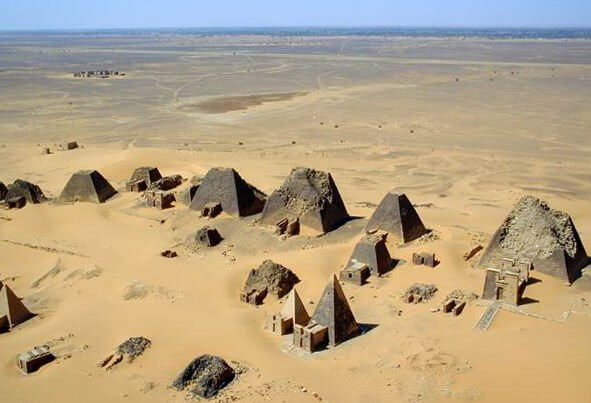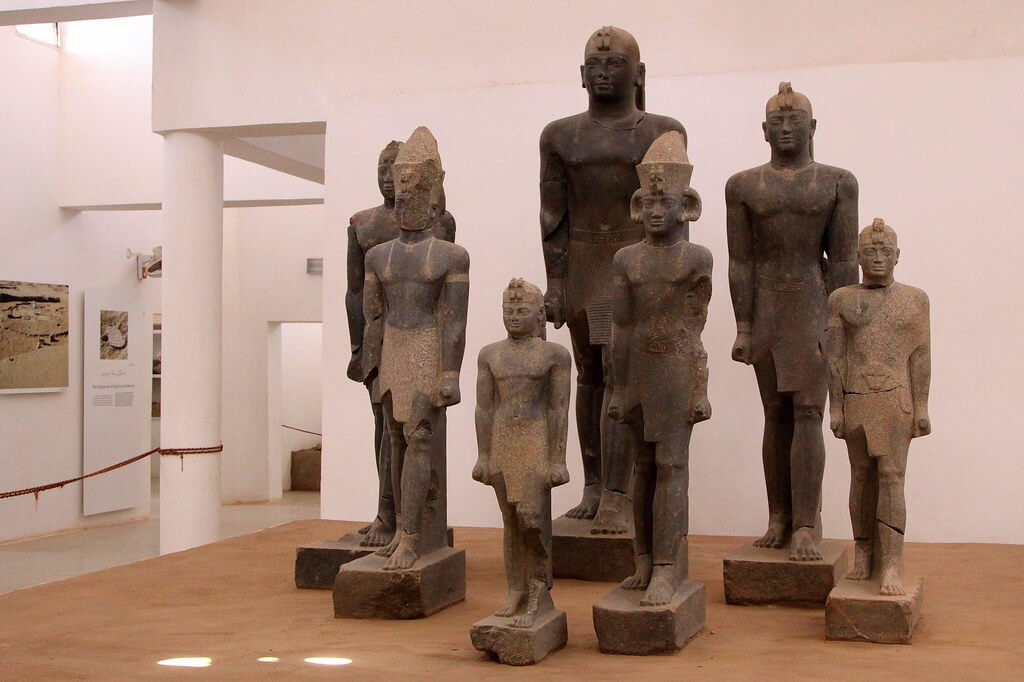For millennia, the ancient civilizations of Egypt and Kush, located in present-day northern Sudan, were intricately intertwined in a profound cultural exchange that left an indelible mark on the Kushite kingdom. This captivating relationship, spanning centuries, transcended mere imitation and evolved into a dynamic fusion of two great powers that shaped the religious, architectural, and artistic landscapes of both civilizations.
In this blog post, we’ll delve into the roots of this influential exchange, explore how it manifested in the realms of religion, architecture, and art, and examine the pivotal role of the Kushite Pharaohs in preserving and reviving Egyptian traditions. Join us on a journey through the tapestry of cultural interchange that continues to fascinate scholars and admirers alike.
The Roots of Influence: Trade and Conquest

The origins of the cultural interplay between Egypt and Kush can be traced back to the Old Kingdom of Egypt (c. 2686–2181 BC), when trade and military campaigns first brought the two regions into contact. As the Middle Kingdom (c. 2055–1650 BC) dawned, Egyptian influence in Kush deepened, leading to the establishment of Egyptian fortresses within Kushite territory. This period of direct control was pivotal in transmitting Egyptian cultural elements to the Kushites, laying the foundation for a profound and lasting exchange.
The exchange between the two civilizations was not a one-way street, however. Kush, with its strategic location along the Nile River, became an important trading partner for Egypt, facilitating the exchange of goods, ideas, and cultural influences. This reciprocal relationship allowed for a dynamic interplay, where both civilizations contributed to and shaped the other’s cultural landscape.
Embracing the Divine: Religion’s Transformative Legacy
Religion was a significant arena where Egyptian influence manifested in Kush. The Kushites, eager to connect with the rich religious traditions of their northern neighbors, adopted many Egyptian deities, most notably Amun, the supreme god of the Egyptian pantheon. The temple of Amun at Jebel Barkal, a sacred site revered by both Egyptians and Kushites, stands as a testament to this religious synthesis.
The Kushite interpretation of Egyptian gods often involved integrating them with local deities, creating a unique religious blend that highlighted both Egyptian and indigenous characteristics. This process of syncretism allowed the Kushites to maintain their cultural identity while embracing the divine influences of Egypt.
Furthermore, the practice of pyramid building for royal burials, a hallmark of Egyptian funerary traditions, was adapted to local customs and styles in Kush, resulting in the distinct Nubian pyramids – smaller and steeper than their Egyptian counterparts. This adaptation of sacred traditions demonstrates the Kushites’ ability to selectively incorporate and transform Egyptian elements to suit their own cultural context.

Architectural Grandeur: Stone Echoes of an Ancient Civilization
Egyptian architectural influence is most visible in the grandiose structures that dot the Kushite landscape. The construction of temples, palaces, and pyramids in Kush followed Egyptian architectural styles but also incorporated distinct local elements, demonstrating a fusion rather than mere imitation. Egyptian motifs, column designs, and temple layouts were skillfully blended with Kushite elements, creating a unique architectural tapestry that showcased the ingenuity and creativity of the Kushite builders.
The Jebel Barkal temple complex, for instance, features a blend of Egyptian and Kushite architectural elements, including the use of Egyptian-style columns and the incorporation of local materials and design features. This harmonious fusion of styles not only reflects the cultural exchange between the two civilizations but also highlights the Kushites’ ability to adapt and reinterpret Egyptian architectural traditions to suit their own cultural identity.
Artistic Expression: A Canvas of Cultural Interchange
Kushite art, heavily influenced by Egyptian styles, especially during the New Kingdom (c. 1550–1070 BC), is a vivid illustration of this cultural exchange. Egyptian artistic conventions, like the depiction of figures in profile and the use of hieroglyphs, were widely adopted in Kushite art. However, Kushite artisans infused these elements with local flavors, evident in the portrayal of Kushite physiognomy and dress in art and sculptures, creating a distinctive aesthetic that celebrated both cultures.
The Meroitic script, a writing system developed by the Kushites, is a prime example of this cultural fusion. Inspired by the Egyptian hieroglyphic system, the Meroitic script incorporated both Egyptian and indigenous elements, reflecting the Kushites’ ability to adapt and innovate within the framework of their cultural heritage.
Through their artistic expressions, the Kushites demonstrated their mastery in blending Egyptian influences with their own unique cultural identity, resulting in a rich and diverse artistic tradition that continues to captivate scholars and art enthusiasts alike.
The Kushite Pharaohs: Cultural Renaissance and Preservation
The zenith of Egyptian influence on Kush can be seen during the 25th Dynasty (c. 747–656 BC), when Kushite rulers, known as the “Black Pharaohs,” conquered and ruled Egypt. This period saw the resurgence of traditional Egyptian art and architecture under Kushite patronage, symbolizing a cultural renaissance. The Kushite Pharaohs not only embraced Egyptian traditions but also played a crucial role in their revival and preservation.
The construction of the Kawa Temple, which features a blend of Egyptian and Kushite architectural elements, is a testament to the Kushite Pharaohs’ commitment to preserving and celebrating the cultural ties between the two civilizations. By actively supporting and maintaining Egyptian cultural practices, the Kushite Pharaohs ensured that the rich heritage of the Nile Valley civilizations would continue to thrive and be passed down to future generations.
Conclusion
The cultural exchange between Egypt and Kush was a dynamic and complex process that transcended mere imitation. The Kushites adopted and adapted Egyptian religious, architectural, and artistic elements, creating a distinct culture that resonated with Egyptian influences yet retained its unique character. This interaction highlights the interconnectedness of ancient civilizations and the importance of cross-cultural influences in shaping the historical narrative of the Nile Valley civilizations.
Today, the legacy of this captivating cultural exchange continues to captivate scholars and admirers alike, inspiring further research and exploration into the intricate tapestry of ancient Egyptian and Kushite civilizations. By delving into this rich history, we can gain a deeper understanding of the profound impact that cultural exchange can have on the development and preservation of great societies.
